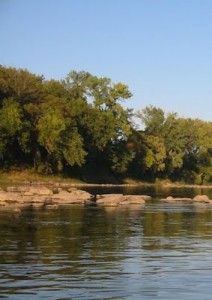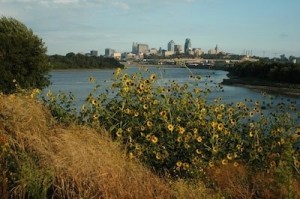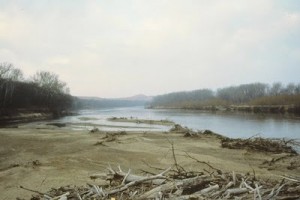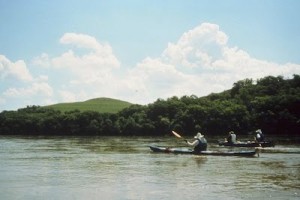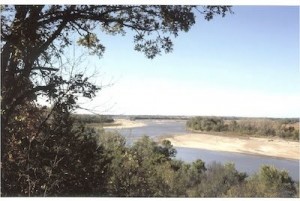View Life on the Kaw: The Historic Kaw in a larger map. Click here for help with our maps.
Geologic history
Long before human history began, geological change a billion years ago created metamorphic and igneous rocks that underlie all of Kansas, but are not visible on the surface. On top of those rocks are layers of sediment put down by shallow seas that rose and fell over time.
About 300 million years ago another oscillating sea covered the area leaving behind layers of shale and limestone. Then, about a million years ago, glaciers moved down from the north. The Kaw River roughly parallels the southernmost tip of the most recent glacier, which covered most of North America about 600,000 years ago, during the Pleistocene Epoch of geologic history. In some places, the ice was 500 feet thick. The huge sheet of ice passed over hills and valleys, bringing with it great loads of rock, gravel, sand and clay that were ground and scraped from the surface of the land they traversed. Boulders of red quartzite and granite, dragged from Minnesota, Iowa, and South Dakota, can be found throughout eastern Kansas. Pictured on right are boulders of red Soiux quarzite and granite visible only during low water just above the access at St. George. An example is the reddish-colored boulder, known as Sioux quartzite, found at the south end of the bridge across the Kaw into downtown Lawrence. It wasn’t found there, but was transported from Topeka. An even more dramatic example can be found on Highway 99 in Waubaunsee County, about five miles north of Interstate 70 at exit 328. On the east side of the road is a field of boulders called a felsenmeer, the German for “sea of rocks.” Geologists believe the edge of the last glacier that covered northeast Kansas left these rocks here.
 Geologists think that the muddy waters of the Kaw are the legacy of glaciation at the time the river was formed. Glacial till, the particles left behind by the glaciers, created the deep, fertile soils of this region, and left the stream beds full of soft sediments. Even if there were no agriculture or urban development in the Kaw River Valley, the water might still be cloudy because of its soft bottom and banks. Changes in weather and climate also can change the character of the river. Some early explorers described the river as clear, others as muddy. As it gets closer to the Missouri River, the Kaw narrows, so the water flows faster, and the channel floor is eroding more quickly. One result is the frequent appearance of fossils of extinct Ice Age animals that are removed from the channel floor. Canoeists regularly find chocolate-brown chunks of bones on sandbars here (pictured on left), and there’s at least one semi-professional collector who tours the river by boat after every high-water event and collects bones to sell to museums. Some of the fossils found in this area have been quite important—mastodons, hairy mammoths, a saber-toothed cat, giant beavers, among others. An exhibit in the basement of the Museum of Natural History at the University of Kansas displays some of these big river fossils.
Geologists think that the muddy waters of the Kaw are the legacy of glaciation at the time the river was formed. Glacial till, the particles left behind by the glaciers, created the deep, fertile soils of this region, and left the stream beds full of soft sediments. Even if there were no agriculture or urban development in the Kaw River Valley, the water might still be cloudy because of its soft bottom and banks. Changes in weather and climate also can change the character of the river. Some early explorers described the river as clear, others as muddy. As it gets closer to the Missouri River, the Kaw narrows, so the water flows faster, and the channel floor is eroding more quickly. One result is the frequent appearance of fossils of extinct Ice Age animals that are removed from the channel floor. Canoeists regularly find chocolate-brown chunks of bones on sandbars here (pictured on left), and there’s at least one semi-professional collector who tours the river by boat after every high-water event and collects bones to sell to museums. Some of the fossils found in this area have been quite important—mastodons, hairy mammoths, a saber-toothed cat, giant beavers, among others. An exhibit in the basement of the Museum of Natural History at the University of Kansas displays some of these big river fossils.
Natural History
A traveler speeding across Kansas on Interstate 70 might get the impression that the landscape is flat and treeless. But that’s just the effect of modern highway engineering. Go a mile off the interstate and you will get a good view of the dramatic changes in ecological provinces from the mouth of the Kaw in Kansas City (pictured on left) to its start in Junction City (pictured on below.)
Along the eastern third of the Kaw, the plant life is not much different from everything east, all the way to the Atlantic seaboard. The woodlands here are part of the floristic province known as the Eastern Deciduous Forest. Douglas County’s Baldwin Woods typify this kind of forest. A rare treasure for Kansas, they were designated a National Natural Landmark in 1980, and are is described as “a unique remnant oak-hickory stand approaching climax condition, located at the western edge of the eastern deciduous forest.” The 200-acre tract is now owned by the University of Kansas and treated as a biological reserve. The land is not open to the public.
As you go farther west in the Kaw River Valley, forests become smaller and more patchy, interspersed with prairie. Near Topeka, the Eastern Deciduous Forest has all but disappeared, replaced by grasslands, scrubby areas that have been invaded by trees, and lowland forests along the rivers and streams. West of Topeka, the land opens into the magnificent vistas of the Flint Hills (pictured below), the largest remaining area of tallgrass prairie in North America. Elsewhere, prairie was plowed for farming by the earliest white settlers, but the rocky limestone and flint of the Kansas tallgrass prairies made them unsuitable for farming.
The change in scenery along the Kaw River is a function of rainfall: near the mouth of the Kaw it averages 37 inches per year; at Junction City, 120 miles west, rainfall is only 30 inches a year.
Transition areas between major habitats, such as forest and prairie, are biologically rich because many different types of plants and animals find their niches there. Kansas, as a whole, has an amazing diversity of life: 3,500 species of plants, 25,000 of insects, and 700 kinds of other animals. Riparian areas along the Kaw provide critical habitat for many types of wildlife, from the tiniest fish—the Topeka shiner— to the biggest bird of prey—the bald eagle. All but red granite and bone picture are courtesy of Craig Thompson.
Human History
People first came to Kansas 12,000 years ago, during the last of the Ice Age, when the climate was cooler and less seasonal than today. Huge animals such as mammoth and mastodon roamed the area until a gradual warming trend brought an end to the Ice Age, and mass extinctions occurred around 10,000 years ago. From 11,000 to 7,000 B.C., people known as Paleoindians arrived here. They were nomadic hunter-gathers who used spears tipped with large chipped stone projectile points. Points of this kind have been found in all parts of Kansas, indicating that Paleoindians were no strangers to the area. The first forms of agriculture arrived in the Eastern woodlands of the state with the Hopewell culture, which flourished from around 200 B.C. to 500 A.D. The museum of the Wyandotte County Historical Society, in Wyandotte County Park, has a great collection of Hopewell artifacts that were found by an amateur archaeologist in back yards of houses not far from the museum. The Hopewell disappeared, for reasons not understood, around 700 A.D.
By around 1000 A.D., people living in this area relied on a dual economy of bison hunting and gardening of corn, squash and beans. In the Protohistoric Period, from A.D. 1500 to 1800, several groups of Indians lived in Kansas. The Kansa Indians, for whom the state of Kansas is named, lived along the Missouri River at least as far back as the 1730s. In the winter, they lived in large grass or brush lodges in villages along streams. The men were excellent fishermen, and the women gardened. During the summer, the people left the village to hunt buffalo on the plains. By 1800, the Kansa had started to migrate west, settling along the Kansas River as far west as Fort Riley. In 1847, when the U.S. government decided it wanted to open the territory to white settlement, the Kansa Indians were relocated to a reservation near Council Grove. In 1873, they were moved again, to a reservation in Oklahoma.
The first Europeans to visit eastern Kansas were the French, who came from the east and formed an alliance with the Kansa. The fur trade grew, attracting more and more white people to the area.
In June, 1804, the Lewis and Clark expedition sailed, rowed, and poled their boats up the Missouri River, stopping for three days to camp at Kaw Point, at the mouth of the Kaw River. (On left is a painting by Ernst Ulmer depicting the encampment at Kaw Point – the area today is a beautiful riverfront park with walking trails, and educational pavilion, and a boat ramp.) Merriwether Lewis, the commander and biologist of the expedition, spent much time ashore studying the animals and plants that were then unknown to the people of the United States. He collected specimens and noted physical characteristics of the land such as springs, soil fertility, and likely sites for trading posts and homesteads. Unfortunately, none of his notes for the spring and summer of 1804 have been found. All we have are the comments of William Clark,his second in command, who noted in his journal, “the country about the mouth of this river is very fine.” They didn’t see any Indians as they passed Kansas, because everyone was out hunting buffalo at the time. Pictured below are Lewis and Clark reenactors at Kaw Point in June of 2004.
Beginning in the 1820s, the U.S. government forced many eastern tribes to give up their land and relocate to what was known as “Indian Country.” Delaware Indians settled north of the Kaw River; Shawnees settled south of the river. Church groups established missionary programs for the newly formed reservations. The first to arrive were the Methodists, headed by the Reverend Thomas Johnson and his wife, Sarah Johnson, for whom Johnson County is named. The Johnsons built a two-story log school north of the Kansas River in what is now Turner, and the school boarded both Shawnee and Delaware children. Baptists and Society of Friends (Quakers) also established missions nearby. To expedite the transition to a farming culture, the ambitious Reverend Johnson persuaded his church to establish a large manual labor school open to Indians of all tribes. The church selected a site south of the Kansas River and erected three large brick buildings for classrooms, chapel, and dormitories. The school grew rapidly: At the height of activity, it had 16 buildings, 2,000 acres, and 200 Indian children ages 5 to 23. Some of the tribes represented at the school were the Kaw (Kansa), Munsee, Delaware, Ottawa, Chippewa, Otoe, Osage, Cherokee, Peoria, Kickapoo, Potawatomi, Wea, Gros Ventres, Omaha, and Wyandot. In addition to religion and academics, boys were taught farming, blacksmithing, and wagon-making; girls were taught spinning, weaving, cooking, and domestic chores.
Discovery of gold in California in 1849 and rapid population growth in California required a central railroad route to connect East and West. “Indian Country” became a desirable location for a railroad, and the Kansas-Nebraska Act organized the region for settlement. By 1854, the U.S. government realized that eastern Kansas was not a hostile desert but was, in fact, a place of fertile land and abundant water. The government made plans to force out the Indians to make way for white settlement. Over the next several years, the Indian missions, including the Shawnee Methodist Mission were closed. Pictured on left are musicans in period costumes at Kaw Point.
Oregon Trail
After the Lewis and Clark expedition of 1804-1806, Americans became aware of the fertile, free land in the place called Oregon. But the route taken by Lewis and Clark, up the Missouri River, seemed interminable, and only a few adventurers and traders made that trip. In 1819, Major Stephen H. Long was sent with a group of explorers to map the plains all the way to the Rocky Mountains. On his map, he labeled the Great Plains the “Great American Desert,” which discouraged travel west of the Missouri River for almost a decade. Many people, disappointed in their fortunes in the United States and dreaming of something better in the West, nevertheless were waiting for news that the country could be traversed by wagon. Wagons were essential for migration, as they carried possessions, sheltered families during the trip, and provided housing at their destination until houses could be built.
In 1832, a caravan made it across the Great Plains and the mountains, to western Wyoming. In 1841, 60 men, women, and children in 13 wagons made it to Oregon. In 1842, John C. Fremont made the trip and provided maps of the route. The following year, 1,000 people emigrated to Oregon along the trail, and the “Great Migration” was on. By 1870, when the transcontinental railroad made the trail obsolete, as many as 200,000 people are estimated to have traveled the Oregon Trail to a new life in Oregon and California.
The trail started in Kansas City, Missou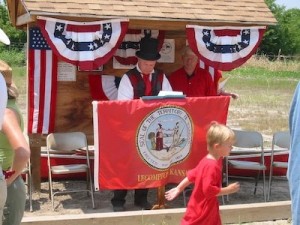 ri, passed through Lawrence, and crossed the Kansas River in Topeka. Pictured on left is a view one might have seen when traveling the Oregon Trail along the Kaw. The trail then went northwest to the Big Blue River in north-central Kansas and into Nebraska. The trail traversed Nebraska, Wyoming, Idaho and Oregon before ending at the Willamette Valley south of what is now Portland, Oregon. The journey, which most settlers made on foot to spare their oxen, was 2,000 miles long and took five to six months. For an overview of the Oregon Trail in Kansas visit the Oregon Trail Nature Park 30 miles northwest of Topeka between St. Mary’s and Belvue just off US Highway 24.
ri, passed through Lawrence, and crossed the Kansas River in Topeka. Pictured on left is a view one might have seen when traveling the Oregon Trail along the Kaw. The trail then went northwest to the Big Blue River in north-central Kansas and into Nebraska. The trail traversed Nebraska, Wyoming, Idaho and Oregon before ending at the Willamette Valley south of what is now Portland, Oregon. The journey, which most settlers made on foot to spare their oxen, was 2,000 miles long and took five to six months. For an overview of the Oregon Trail in Kansas visit the Oregon Trail Nature Park 30 miles northwest of Topeka between St. Mary’s and Belvue just off US Highway 24.
Pre-Civil War Kaw
Contention over slavery had divided the country for more than 40 years when Congress passed the Kansas-Nebraska Act in May 1854. The law opened the two territories for settlement and proclaimed that the new residents would vote on whether slavery would be allowed in the territories. People on each side of the slavery issue rushed to get to Kansas and become residents. Pro-slavery Missourians—who already had 12,000 slaves living across the state line—got here first, of course, and began to stake claims along the eastern edge of Kansas and along the Kaw. Within a month of the territory’s opening, though, the New England Emigrant Aid Company sent Dr. Charles Robinson and Charles H. Branscomb with a small party of settlers to travel across the country and select a site for a town. They arrived on the first of August 1854, and a second party from Massachusetts arrived about a month later. The town site they chose was named Lawrence in honor of Amos A. Lawrence of Boston, a generous contributor to the New England Emigrant Aid Company. These settlers were known as Free Staters because they intended to prevent Kansas from entering the union as a slave state. The stage was set for the many battles that gave the state the nickname “Bleeding Kansas.”
Thousands of “Border Ruffians” from Missouri came into Kansas to vote in territorial elections, giving a majority to a proslavery faction, which took power and named Lecompton as territorial capital. For a few years, Lecompton thrived: Its population reached 4,000, it boasted five fine hotels, stage and ferry served it, and it became known as “Wall Street of the West” because the settlers and land speculators poured into the federal land office to stake their claims. You can visit that land office in Constitution Hall, now managed as a state historic site. In 1857, the proslavery Territorial Legislature meeting at Lecompton wrote the Lecompton Constitution, which called for Kansas to enter the union as a slave state. While this new Kansas constitution was being debated by Congress—an incendiary debate that started the nation down the path to Civil War—another constitution was drafted at Leavenworth and approved by the people of Kansas in 1858. That constitution also failed to win acceptance in Washington. Finally, a constitutional convention met in July 1859 in Wyandot, now part of Kansas City, Kansas, and was adopted by popular vote in October 1859. The Wyandot Constitution declared that Kansas would be a free state. The U.S. House of Representatives voted in April 1860 to accept the constitution and admit Kansas to the Union. The proslavery majority in the U.S. Senate, however, refused to act on the Kansas constitution. The Republican candidate for president, Abraham Lincoln, ran on a platform of immediate admission to the union for Kansas. When Lincoln won the election, Southern states seceded from the nation and removed their representatives from Congress. Both houses of Congress then passed the bill admitting Kansas to the nation, and President James Buchanan signed the bill into law on January 29, 1861. Kansas, after much turmoil, that day became the 34th state of a rapidly disintegrating nation.
Territorial Capitols
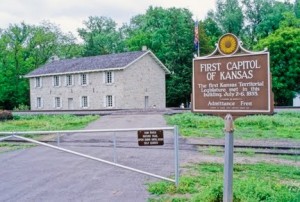 The Kansas Capitol moved several times in its early years as a Territory: In the summer of 1855, Governor Reeder declared Pawnee, near Fort Riley, to be the Territorial Capitol (on left). The Legislature met in a hot warehouse building for four days, then rebelled and moved itself to the Shawnee Methodist Mission where facilities were more comfortable. The Mission remained the seat of government for several years.
The Kansas Capitol moved several times in its early years as a Territory: In the summer of 1855, Governor Reeder declared Pawnee, near Fort Riley, to be the Territorial Capitol (on left). The Legislature met in a hot warehouse building for four days, then rebelled and moved itself to the Shawnee Methodist Mission where facilities were more comfortable. The Mission remained the seat of government for several years.
In 1855 and 1856, the U.S. Congress appropriated funds for the construction of a Capitol building in Lecompton. Grand plans were drawn up, but funds ran 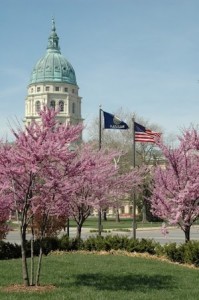 out before the first floor was completed.
out before the first floor was completed.
In 1861, after Kansas was admitted to the Union as a state, the capital was moved to Topeka. Construction of a Capitol building began in 1866 and the Legislature met there for the first time in 1870. In 1903, the building was completed. Photo on right of the State Capitol in the spring as well as the first Territorial Capitol above are courtesy of Craig Thompson.
Flooding
From time to time, great floods on the Kaw filled the river valley from bluff to bluff. In historic memory, there have been four great floods, three of them in the 20th century. Experts believe that 1844 was the worst flood in history on the Kaw, with floodwaters reportedly reaching what is now the campus of Kansas State University in Manhattan, 40 feet above the normal stream level. Because there was no permanent settlement along the Kaw at that time, damage to structures was not extensive, but the flooding caused an unknown amount of hardship to Indians and wrought ecological damage. Picture below is of the Vermillion River entering the Kaw just east of Wamego in spring of 2007 – the Kaw was just below flood stage.
The second great flood occurred on May 31, 1903, when the river was two to five miles wide, flooding farmland along its entire length. The flood killed more than 20 people and left tens of thousands homeless. In parts of Topeka, floodwaters were 12 feet deep. People still continued to settle in the floodplain, setting the scene for the worst disaster in the history of Kansas: the 1951 flood.
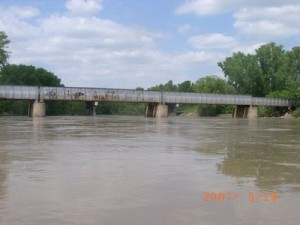 Above-normal precipitation in May and June of 1951 saturated the ground and made conditions favorable for runoff when rainy weather returned in July. From July 9-13, as much as 16 inches of rain fell in some areas of eastern Kansas. The river rolled out of its banks and did extensive damage in Manhattan, Topeka, Lawrence, and Kansas City. The damage in Kansas and Missouri was unprecedented. At least 19 people were killed and 1,100 injured. From the headwaters of the Kansas River to the mouth of the Missouri River at St. Louis, about 2 million acres were flooded, 45,000 homes were damaged or destroyed, and 17 major bridges, some of them weighted with locomotives in an attempt to hold them, were washed away. By October of 1951, estimates of the total damage ranged as high as $2.5 billion (about $17 billion in 2000 dollars).
Above-normal precipitation in May and June of 1951 saturated the ground and made conditions favorable for runoff when rainy weather returned in July. From July 9-13, as much as 16 inches of rain fell in some areas of eastern Kansas. The river rolled out of its banks and did extensive damage in Manhattan, Topeka, Lawrence, and Kansas City. The damage in Kansas and Missouri was unprecedented. At least 19 people were killed and 1,100 injured. From the headwaters of the Kansas River to the mouth of the Missouri River at St. Louis, about 2 million acres were flooded, 45,000 homes were damaged or destroyed, and 17 major bridges, some of them weighted with locomotives in an attempt to hold them, were washed away. By October of 1951, estimates of the total damage ranged as high as $2.5 billion (about $17 billion in 2000 dollars).
After the flood of 1951, the U.S. Army Corps of Engineers built levees and reservoirs on tributaries of the Kaw in hopes of containing the river in future floods. The complex system of levees, dams, and reservoirs was expensive to build and maintain. Many opponents argued against the flood control measures, but eventually the system was completed.
Most of the dams were focused on protecting property from 25- or 50-year floods, and were no match for the flood of 1993. A wet winter and spring that year were followed by record amounts of rainfall in July – as much as 24 inches for the month in some Kansas locations. Dams on the reservoirs were closed to contain as much of the rainfall as possible; Tuttle Creek on the Blue River north of Manhattan, for example, expanded to four times its usual size. But in July, the reservoirs reached their limits and the focus switched to protecting the dams from collapse. Water was released into the rivers, causing flooding along the Kaw, and worsening the catastrophic flooding on the Missouri and Mississippi rivers.
For more details on the history of Kansas River flooding, visit this U.S. Geological Survey’s publication.
